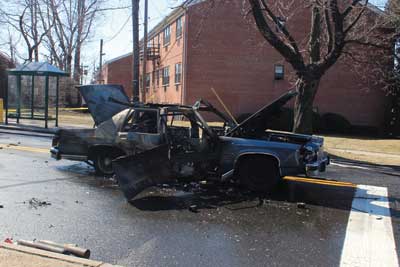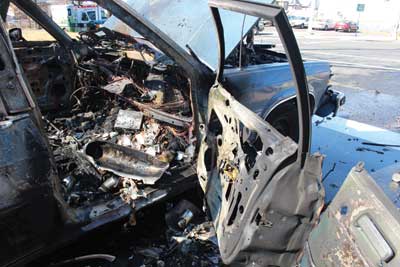BY STEPHEN KALMAN
On February 28, 2012, at 1108 hours, the Hackensack (NJ) Fire Department responded to a reported vehicle fire in the street in front of 504 Hudson Street, in the extreme south end of the city. Engine 1 was dispatched along with the rescue company to assist, our standard response. As Engine 1 approached the scene, members observed a fully involved vehicle. Simultaneously, dispatchers advised the units that the police reported oxygen cylinders were exploding in the vehicle. The on-duty tour commander, Deputy Chief Kenneth Kalman, responded on this report; he ordered an additional engine company to respond.
 |
| (1-4) Photos courtesy of Thomas Bischoff, Bergen County Hazardous Materials Response Unit. Click to view video. |
Engine 1 positioned about 150 feet from the burning car, which was directly in front of an occupied commercial building, and members stretched a 1¾-inch hoseline. At this time, an additional explosion occurred, completely blowing the roof off the vehicle and sending it crashing about 15 feet away from Engine 1. Water was started, and members operated from a distance in an attempt to apply water to the burning vehicle. Some fire was knocked down.
On Kalman’s arrival, he ordered that a water supply be established to Engine 1, all members back away from the vehicle, all nearby civilians move back to a safe area, and the apparatus-mounted multiversal be put into operation to complete extinguishment and cool any cylinders left in the vehicle.
 |
Ladder 1 was ordered to the scene to evacuate and search the one-story commercial building, which was the main exposure, and check the roof for any extension or cylinders. One cylinder had entered the building through an open front door; one large window was blown out, and two others were dislodged. There was also some minor damage inside the building, which housed a wholesale aquarium supply business.
The fire began when an elderly man requiring the use of oxygen for breathing lit a cigarette while he was stopped at a traffic light. The interior of the 1987 Mercury Marquis was filled with his personal belongings and a large accumulation of rubbish, which was believed to be oxygen-saturated since the fire reportedly developed rapidly. Eight three-pound cylinders were in either the interior or trunk of the vehicle. At least five of the cylinders exploded; three exited the vehicle. The operator of the vehicle was living in a nearby hotel, and a civilian was credited with removing him, apparently disoriented, from the burning vehicle prior to the fire department’s arrival.
The lieutenant from the first-arriving Engine 1 suffered an ear injury. One police officer and three civilians, including the operator of the vehicle, reported minor injuries.
 |
LESSONS LEARNED AND REINFORCED
This incident reinforces the fact that you have to be aware that there is always the potential for encountering the unknown in vehicle fires. A burning vehicle can contain a wide array of containers and devices that can explode, become missiles, or produce shrapnel. For example, aerosol cans of flat tire sealant commonly explode when fire reaches a vehicle’s trunk. Additionally, a growing number of automobiles have cylinders of nitrous oxide installed to enhance their speed and performance. Modern automobiles commonly have gas-filled struts to assist in raising hoods, trunk lids, and hatchbacks—the struts can explode when heated and launch themselves as rockets. Similarly, cylinders for energy-absorbing bumpers are also prone to exploding. Air bag inflation modules are designed to deploy normally when exposed to fire; however, there are several documented cases of their exploding and producing shrapnel that can penetrate the vehicle’s roof.
 |
Firefighters should protect themselves from flying metal fragments and missiles at every vehicle fire by attacking the fire from a safe distance. Consider that many fire departments attack vehicle fires with a 100-foot hoseline stored and preconnected to a discharge in a well in the front bumper of the apparatus. Deployment of this short hoseline necessitates that apparatus be positioned relatively close to a burning vehicle, perhaps too close.
Firefighters should attack every vehicle fire as if it were a pressurized vessel that could explode—that is, use the reach of a stream to knock down the fire and cool the vehicle from a safe distance. Experienced firefighters fight vehicle fires according to two fundamental principles: First; it is not necessary to get “nose to nose” with a burning vehicle; control the fire from a distance. Second, once a vehicle fire extends beyond its area of origin, it cannot be repaired; the vehicle becomes junk that is not worth the risk of injuring a firefighter. There is nothing of value to save.
STEPHEN KALMAN is a 26-year veteran of the Hackensack (NJ) Fire Department, where he is the deputy chief of training. Previously, he was assigned as a tour commander and was an engine company officer for 13 years. He is also a level-II NJ state-certified fire instructor and teaches at the Bergen County Fire Academy. He also served as a volunteer firefighter for 22 years.
Fire Engineering Archives

